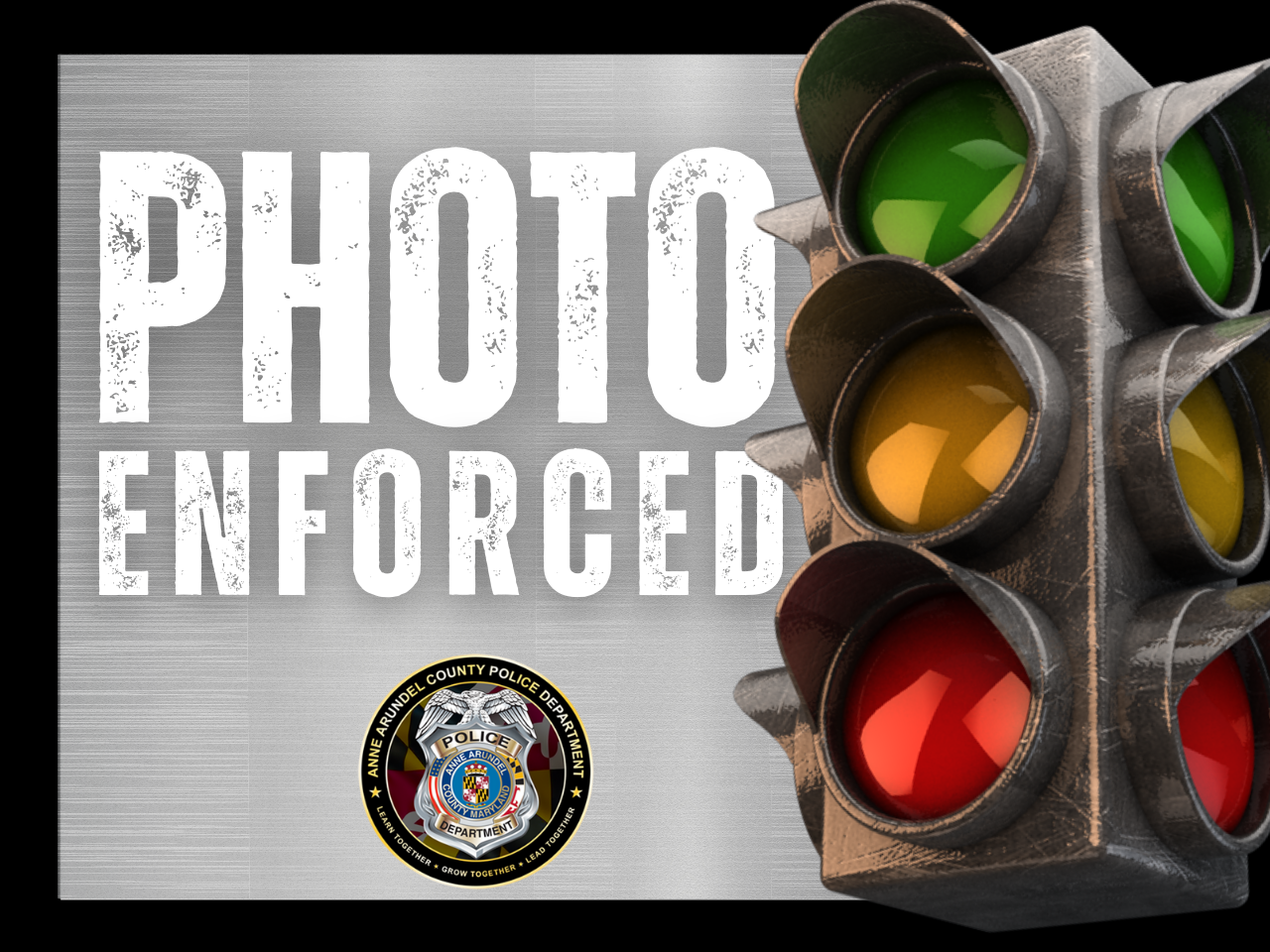About
The Anne Arundel County Automated Traffic Enforcement - Red Light Camera Program uses fixed camera units to monitor and enforce red traffic signal violations. The goal of the program is to improve traffic safety by reducing the number of red traffic signal violations.
The Anne Arundel County Police Department strongly supports the Red Light Camera Enforcement Program. Red light cameras are a proven tool for reducing violations and preventing motor vehicle crashes.
Hours of Operation
In accordance with state law, red light cameras will operate 24 hours a day, seven days a week. The use of red light cameras is authorized in Maryland by the Maryland General Assembly under Transportation Article 21-202.1.
Warnings & Citations
Signage will be implemented to notify drivers of the newly installed red light cameras. The system will only issue warnings for the first 30 days at each designated location. After the 30-day warning period, the cameras will issue citations with a $75 fine for red traffic signal violations.
A violation occurs and a citation may be issued if:
- A vehicle crosses the stop line and continues through the intersection while facing a red signal; or
- A vehicle crosses the white stop line completely while facing a red signal.
A violation does not occur, and a citation will not be issued if the vehicle crosses the white stop line and enters the intersection while the light is yellow and is still in the intersection when the light turns red.
The camera will take a photo of the violating vehicle’s license plate and record all the relevant data associated with the violation, including the date, time, and location. The citation will be mailed to the vehicle's registered owner with images of the violating vehicle.
Upon receipt of the citation, the vehicle owner can send payment, request for appeal, or written correspondence to the designated mailing address.
Red light camera citations are civil citations, not moving violations. They are not reflected on driving records, and no points are assessed. Insurance companies cannot access red light camera violation information or raise insurance rates due to camera violations.
The registered owner of the vehicle is the responsible party in Maryland, regardless of who was driving the vehicle at the time the citation was issued. Citations are sent to the address of the vehicle’s registered owner on record with the Maryland Motor Vehicle Administration within 14 days of the violation.
If you receive a citation, you have the option to pay the fine or request a court hearing. Failure to do either in a timely manner may result in MVA flagging and refusing to renew the vehicle registration. If this happens, the vehicle’s registered owner is liable for an administrative motor vehicle flagging fee in addition to the original fine to renew their vehicle registration.
Pay a Citation
If you have a question about paying a citation, please contact (844) 513-0144
Camera Locations
Red light camera locations will be clearly marked with signage. Camera placement is determined through an evaluation of crash history and red light violation rate analysis.
Red Light Cameras are installed at the following locations:
Red Light Cameras are planned to be installed at the following locations:
Red Light Cameras were previously installed at the following locations:
Current Location Map
Suggest a Camera Location
Do you have an intersection you feel is a safety concern for red light violations? Please let us know about it so it can be reviewed for possible program expansion.
As an alternative, you can send an email to the Program’s Manager at PoliceATEU@aacounty.org
Frequently Asked Questions
The cameras and detection devices are mounted on dedicated metal poles before and/or after an enforced intersection approach.
If you receive a citation, you have the option to pay the fine or request a court hearing. If you wish to schedule a hearing, you are required by law to mail a request to the police department's Automated Traffic Enforcement Unit, and it must be received five days before the payment's due date. You will be mailed a notice of the court hearing date, time, and location. If you appear in court, the maximum amount you may be charged is a $100 fine and court costs.
Anne Arundel County red light cameras do not monitor right turn lanes. However, if a police officer observes a vehicle failing to make a complete stop at a red light before making a right turn, the officer may issue a traffic citation.
Yes. A 30-day warning period will be in effect at each new camera location before citations are issued.
The fine is $75. There are no added late fees. The addition of an MVA administrative flagging fee applies if the citation goes unpaid and the vehicle registration is flagged as a result.
- Pay online: Visit https://usview.cite-web.com/ to pay a citation. Major credit cards are accepted. The online payment service has an added $4.00 convenience fee.
- Pay By Phone: Call 844-513-0144
- Mail a check: You may also mail a check for the amount due, along with the payment stub attached to the citation, to Anne Arundel County, P.O. Box 13323, Baltimore, MD 21203. Checks should be made payable to Anne Arundel County.
Similar to a parking ticket, the registered owner of the vehicle is the party responsible for ensuring the citation is paid, regardless of who was driving the vehicle at the time the citation was issued.
Dedicated Red Light Camera Program personnel constantly assess all active camera locations and review the quantity of red light running incidents and citations issued. Moreover, the Anne Arundel County Police and Traffic Engineering departments regularly consider intersections that may warrant the introduction of red light safety cameras based on crash data.
Before a camera is installed, traffic engineers have attempted to eliminate red light running collisions by altering signal timing or adjusting traffic flow in another manner. A camera is added only after other engineering measures have been attempted.
Maryland law requires revenue from such programs to be utilized for public safety programs such as the Police Department.
No. Maryland law prohibits the use of red light cameras for any purpose other than enforcing red light violations.
If a vehicle crosses completely over the white stop line while facing a red signal, a violation has occurred, and a citation may be issued. However, if the driver only partially crosses the stop line before coming to a stop, Anne Arundel County Police will not issue a citation.
No. If your vehicle has crossed the white stop line and entered the intersection while the light is amber (yellow), and then the light turns red while the vehicle is still in the intersection, a citation will not be issued.
The citation is sent to the address of the vehicle’s registered owner on record with the Maryland Motor Vehicle Administration (MVA). By law, citations must be mailed within 14 days of the violation. Anne Arundel County typically processes and mails citations within three to eight days after a violation occurs.
The citation will include three pictures showing the vehicle committing the violation and its license plate number. It will also include the exact date, time, and location of the violation, a violation number, the amount due, the due date, and instructions for paying the fine or requesting a court date.
The vehicle’s speed, the road’s speed limit, the length of the amber (yellow) light, and how long the light was red when the photographs were captured are all included. It also consists of a signature of the certified Anne Arundel County police staff member who reviewed the images and determined if the criteria to issue a citation were met. Additionally, red light citations include a link to a website to view the photographs and full motion video and pay the fine.
When radar technology recognizes that an approaching vehicle is exceeding a preset threshold speed prior to the intersection, the camera system initiates a photograph sequence. The camera first captures a wide-angle photograph of the vehicle before it enters the intersection, with the traffic signal clearly illuminated red.
Shortly thereafter, the camera captures another photograph of the vehicle in the intersection with the traffic signal still illuminated red. A photograph of the license plate is cropped from one of the two wide-angle images.
The cameras also utilize supplemental full-motion video evidence to substantiate the violation event captured by the still photographs. A multi-step review process occurs before issuing a citation and trained Anne Arundel County Police Department staff make the final determination as to whether the criterion to issue a citation was met.
Failure to pay the fine or request a hearing in a timely fashion may result in the vehicle's registration being flagged and, therefore, the MVA refusing to renew it. If this happens, the vehicle’s registered owner is liable for an administrative motor vehicle flagging fee with the MVA in addition to the original fine for renewing their vehicle registration.
Red light camera citations are civil citations, not moving violations, similar to parking tickets. They are not reflected on driving records, and no points are assessed. Insurance companies are not permitted to access red light camera violation information or raise insurance rates due to them.
For customer service regarding red light camera citations, contact 844-513-0144
Contact Information

Vision Zero
Vision Zero aims to prevent all traffic-related fatalities and serious injuries in Anne Arundel County while increasing safe, healthy, and equitable mobility for all.
2030 Target: Reduce Fatalities 50% by 2030
2040 Goal: Reduce Fatalities 100% by 2040
The Automated Traffic Enforcement Speed Program will help us to reach these goals by expanding enforcement and changing human behavior in critical areas.

